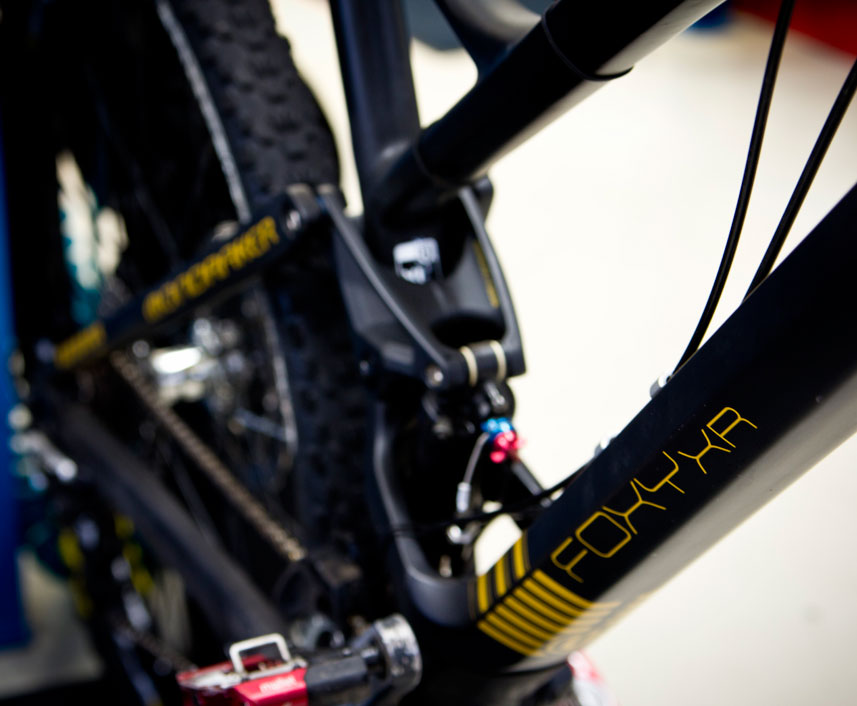"For me, the limits are around 62.3° head angle, 850mm for the front centre and 335mm for the BB height. It may not be the same for you - so start experimenting, kids!"

Chris’s 2014 mule was the Mondraker Foxy Carbon
From August 2014. Author: Chris Porter.
I’ve been trying to build longer, slacker and lower bikes for years. Normally it’s the case that anytime I manage to push a new maximum in terms of wheelbase, head angle and bottom bracket height (or lack of it) the bike is always better. I figured that at some point, if I kept going, I’d reach a set-up that isn’t as fast as the last one, offers less confidence or negatively alters the handling of the bike. Well, interestingly I think I have just about reached that point.
My new Foxy Carbon XR has a BB height of 330mm, a front centre of 857mm and a head angle of 62.3° and with a ‘RAD’-style Fox 34 fork. The bike absolutely hauls over the bumps. Essentially the height of the BB means your feet is almost swinging under the axle as the front wheel hits the bump, in the same way that a 29er chassis does with a ‘normal’ BB height. Basically, you are transferring weight under the contact patch. In a flat turn with bumps the speed you can carry is amazing.
“Finally I managed to make a front centre long enough and low enough that I can’t stop, I run wide and the rear shock hangs up on everything”
However, like it is with a 29er, it’s very difficult to slow down using the front brake because you are weighting the front wheel with your hands and un-weighting it with your feet. By reducing the BB to the level I have you, also tend to struggle to change direction in consecutive turns. Again the feet below the axle help with stability in a settled, constant radius corner, but when initiating a direction change you need a certain amount of height to transfer weight to the front wheel. So it’s swing and roundabouts; you gain here, you lose there. Up till now it’s been so much gain, the losses have been easy to ignore.

Finally I managed to make a front centre long enough and low enough that I can’t stop, I run wide and the rear shock hangs up on everything (remember for every front wheel action, there’ll be a rear wheel reaction). So this week’s experiment has been to raise the BB height to 340mm (which is still lower than even the lowest stock bike) and reduce the front centre by using a 7mm shorter fork offset. This is achieved by using the 26in version of the new Fox 36 fork with a 27.5 wheel (don’t try this at home, kids).
The result? Just that small change in height and length has been enough to transform the way the bike gets ‘into’ corners without really spoiling the benefits on bumps.
Now I’m getting to the point where I’m adjusting small things to suit tracks better. I can raise the BB to get more weight transfer for the fast approaches to tight hairpins I might find on the Trans Provence, but drop the BB to get the bike to carve the tiny cambers on my flat, wet, local turns in the winter. Interestingly the reduction in offset kind of backs up my theory that head angle trumps offset when you need to lean the bike. Offset looks great for stability on a flat 2D drawing (so straight line riding), but when the bike leans over it gets way more complicated and even Honda Racing wouldn’t suggest they understand it all.
There is a fashion in mountain biking at the moment to use offset as a substitute for head angle (bicycle designers are for the most part scared of slack head angles) but I’m more interested in how a bike turns than how safely I can take my hands off the bars at low speed. If the bars flop on the flat I’ll work on my core strength.

Chris has also played around with different offset forks, to adjust steering stability, trail and front centre length
Anyone interested in messing with BB heights may have an adjustable bike (usually a flip chip at the linkage), can use offset bushings or can ask us to make a custom length/travel shock (the expensive option). Shortening the shock on a VPP bike usually has the additional benefit of by-passing some of the ‘rearward’ axle path b****cks at the first part of the stroke and making the rear centre static measurement longer. At some point the wheel will have to get over the bump, so moving it backwards in the soft part means that you are getting over the bump deeper in the suspension when it is transferring more energy to the chassis.
Dropping shock length also slackens the head angle and lengthens front centre too. Even slacker head angles are achieved using an offset headset. I use the Works Component ones which are capable of a 3 degree change (with 1 1/8in steerer). Every degree of head angle will lengthen the front centre by around 12mm.
So for me, the limits are around 62.3° head angle, 850mm for the front centre and 335mm for the BB height. It may not be the same for you – so start experimenting, kids!





